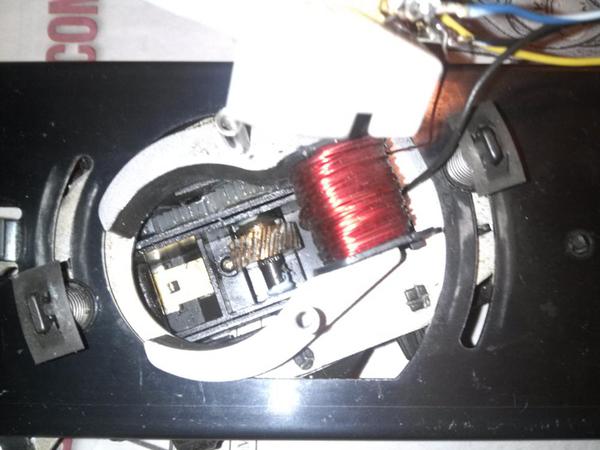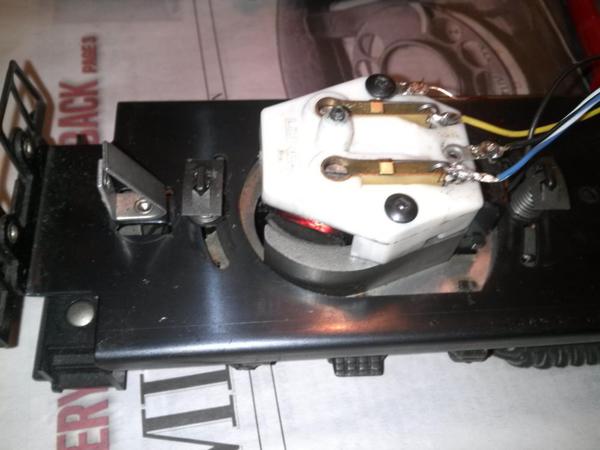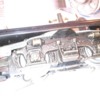Could you help me find an armature for an 8010-11 motor truck or the complete motor truck? The motor originally ran but with a loud clicking. But now the armature attempts to turn, then halts and buzzes. I tested continuity on the three phases and even re-soldered the phase contacts, but the symptom still persists. Mechanically, the armature turns smoothly in the truck, so it would appear that a winding has failed.
Replies sorted oldest to newest
I doubt the armature is the problem. More likely the motor sideframe staking has come loose and the armature strikes the field when energized.
To check the armature more thoroughly, check the continuity between all poles of the armature to each other. The resistance should be the same on all 3 readings within a few tenths of an ohm. Next check the resistance of each armature winding to the armature shaft. You should get an open circuit. If you get any reading on any winding, the armature is shorted.
As has been stated, you may have a mechanical problem, but it is good to know if your armature is ok.
Larry
Chuck, Larry,
Thanks so much for the insightful comments. All poles of the armature reflect 1000 ohms against the opposing two poles. Initially I suspected that the bushing truck base in which the armature turns was the culprit because of the noise (the "striking" Chuck refers to). Since the motor side frame and other truck mechanical components seem firmly attached, that certainly supports the bushing wear conclusion. While the armature seems to turn manually without striking by rotating the wheels, and I can't detect play. it seems strange that under power it will only rotate 1/3 turn forward and reverse before it stops and buzzes. I guess there is just enough play in the base opening that receives the lower end of the armature shaft that it binds against the side frame magnet. I double checked the wiring as well with no problems found.
I guess I could attempt to build a bushing to fit the armature base, but alignment would certainly be a challenge. But I also suspect that the bushing design is a possible problem on any used MPC era 8010-100 truck I could find. Perhaps bushing fabrication is the only option other parting it out.
I bought the GP 20 used at a local train show for the low nose, but the diesel never worked well. I bought a post-War 2300 series chassis thinking the shells were interchangeable, but my curves are O-27 and the motor strikes the inside of the cab unless the GP 20 shell is positioned about 3/16" forward.
Did you check the resistance from the commutator bars to the motor shaft? Your description of the operation could be a grounded armature coil.
1,000 ohms sounds very high for the resistance between any two commutator segments. Is that where you took the reading?
Regardless, I am fairly certain I have some 8010-11 armatures, and a complete motor truck that could be used to replace yours. I assume it is a switcher truck with a double wound field (for either a two position e-unit or a manual switch). Drop me an email if you are interested.
There are some variations on your truck. A photograph of the bottom, showing the pickup rollers, would be interesting to see.
Did you remember to replace the insulating washer on the brushplate screw that has the field solder lug on it?
Thanks to all for all your great help and insights. I'll try to answer each comment by name.
Larry & David: I checked and confirmed there is no continuity between the armature center shaft and the commutator phase lobes. I did not de-solder the armature wires but confirmed continuity exists across all three phase lobes.
Charlie S: I misstated the resistance between commutator phase lobes. There is continuity, "0" Ohms I believe. Sorry for the confusion on my part.
Chuck: There was no insulating washer on the lug screw that I recall. But doesn't the screw need to provide continuity from the winding lug to the chassis as a ground? I thought the white plastic brush plate would not need any insulating washer. I went back to the Lionel motor breakout and found no washer on this MPC era GP 20 model.
Again, the truck is an 8030-100 or 8665-100 used in the GP 7, GP 20, and U-36B units. The Lionel truck parts breakout from 1978 is on page 15-32, about 384 pdf images deep in bulletins 1-9 from the Lionel web site. This is a low end locomotive without horn but does have lights and uses the 3 position e-unit.
Again, many thanks to all for the willing help. I'm learning, albeit slowly!
Attachments
Did you remember to replace the insulating washer on the brushplate screw that has the field solder lug on it?
I bought a post-War 2300 series chassis thinking the shells were interchangeable, but my curves are O-27 and the motor strikes the inside of the cab unless the GP 20 shell is positioned about 3/16" forward.
I have successfully used a grinding wheel to take material off the brushplate and use the early chassis with the low nose. It works quite well.
I checked and confirmed there is no continuity between the armature center shaft and the commutator phase lobes. I did not de-solder the armature wires but confirmed continuity exists across all three phase lobes...
...I misstated the resistance between commutator phase lobes. There is continuity, "0" Ohms I believe. Sorry for the confusion on my part.
I have exactly 1 8010-100 armature that passes all tests but cogs in the motor like yours, and it was confounding. I replaced it with a 600-125 armature and the engine runs beautifully.
OK, big difference. You stated you had a 8010 truck. What you have is a 8030 truck. Two totally different trucks. Does it not operate in either forward or reverse? Try on your workbench 2 power leads and hold it with one hand while attempting to run. With your thumb try to move the bottom plate that has the pick-up strip on it either left or right and see if it wants to run.
Thanks Rob, Thanks Chuck,
Chuck: I'll do the troubleshoot later tomorrow. There is a plastic anchor alignment blister holding the brass strip in place so I'll see if moving it helps. It does appear that the armature center shaft may actually touch the brass spring that holds the collector rollers.
Rob: I considered grinding but suffered "faint heart" syndrome (;>}) I did swap the brush plate for the hexagonal shape but clearance was still an issue. I'll experiment a bit more. Thanks for the feedback!
quote:I have exactly 1 8010-100 armature that passes all tests but cogs in the motor like yours, and it was confounding. I replaced it with a 600-125 armature and the engine runs beautifully.
I had one as well. I suspected that the commutator plate was out of alignment, but never resolved the issue.
I checked that, it was fine.
If the armature is striking the side of the field, there will be scratch marks on it...
Marty
quote:Charlie S: I misstated the resistance between commutator phase lobes. There is continuity, "0" Ohms I believe. Sorry for the confusion on my part.
Zero is a bad reading too. That would be a short. I find that most Lionel armatures read about 1 to 1.2 ohms between any two commutator segments. I always check all three pairs, they should all have the same reading.
And check each segment to the armature shaft - all should read infinity, no circuit.
ADCX- this is motor I rebuilt its your gear knowledge.
I replaced the worm gear using a brass one. The drive gear a metal one...and the pinion gears.
Is is it possible it is just the set screw on top is to tight. Or movement in the worm gear?
You're going to have to include more information on the problem you are having, and maybe some photos, in order to help you out.
Again, thanks to all for great comments and insights.
Chuck: Sorry for my confusing the issue with the wrong truck number. I tried powering the motor again as you suggested but nothing I did to move the brass collector plate would change the symptom, which I observed more closely and must further clarify. The motor rotates only 60 degrees, not 120 degrees or 1/3 of a rotation.
CW: I did confirm there are no shorts between the armature shaft and the three commutator phase lobes. My ohm meter (simple Radio Shack 22-218A) reflects continuity between the three commutator lobes and no observable resistance, but that may be a sensitivity issue. I'll try again and find a more sensitive ohm meter.
Shawn: I've adjusted the set screw several times with no change in symptoms. The motor responds to the E-unit correctly and turns 1/6 of a turn in forward or reverse, but no further.
Again, sincere thanks to all!
Try another brush plate, it sounds like the hole in the brush plate is elongated.
Bill
Try another armature, I'll bet the brushplate is fine.
You may be narrowing the problem down to an electrical problem with the armature. You need better bar to bar resistance meter readings on the commutator to be sure. One other thing to look at is there should be two small wires coming to each of the three commutator connections. At each connection there will be one wire coming from each adjacent armature coil. Look very closely at these wires to be sure that they are connected. That they are not broken and that the solder joint is good. If one of those wires is loose, the motor will act as you have described.
David: In one of my earlier posts I mentioned inspecting and actually carefully re-soldering the three contacts. Good news is Charlie S has a replacement truck so I will go that way. I'm guessing that either the armature is bad or there is a mechanical issue I am not recognizing.
Boxcar Bill: I will have a careful look at the brush plate with my magnifier.
To ALL: I really appreciate the tremendous outpouring of help from across the OGR Forum. What a tremendous resource you all are! I'm an old military guy and you all have my smart salute O> Thanks!
Martin: I missed replying to you. There is no sign of striking other than a rather loud whirr when the loco was actually running in times past. The reverse was also an issue as the motor labored more in reverse. I was excited when I bought the GP-20 a few years ago, but I came away with a distain for the MPC era products. There were so many more engineering shortcuts when they are compared with the great post-War era gear. So I'll continue to lean toward the latter from here on out! Thanks again for your feedback!
http://home.earthlink.net/~dlpearce74/
Here is a reference to a worm gear and drive gear replacement if ever needed.
The pinion studs on the MPC version are plastic/ The plastic pickup housing that is inserted between the the swedged plates are available from mikes train and hobbies.
I did a rebuild of a bad truck rebuild with some help from rob. He provided references to the gears. I installed a brass worm gear and metal drive gear. The motor runs great.
Hope this helps you in the future.
Shawn, All,
Thanks for a great and insightful reply and instruction. The perspectives and clues on available parts will be invaluable.
Yesterday I learned independently what you outlined concerning the similar design between the 600 series and the MPC era GP series trucks when I disassembled my 603 Erie switcher and discovered that the armature was the same as the one in the GP-20. I swapped the armatures and BOTH locomotives started and ran, pulling a small three car passenger consist. That proved that the GP -20 armature was not the problem, but that, as others have observed, the issues are mechanical. Thanks for your instructions on gear and plastic pinion stud replacement. As soon as the replacement GP-20 truck arrives, I'll research the needed parts and decide on the way ahead.
Again, thanks Shawn, CharlieS, and all the others on the forum for great comments and inputs. And thanks as well to OGR for sponsoring and supporting this great on-line tool!












